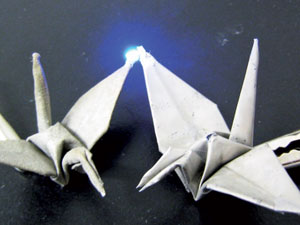We normally think of electronic components as being inflexible but researchers in Japan are challenging this concept by reinventing paper.
And they’ve used their paper electronics to create origami-style lights.
Antennas transmit and receive information and although they have been put on paper before, none of these antennas have been foldable. This is because the conductive materials struggle to stay on the coarse and porous surface of the paper, resulting in deterioration of their electronic properties. Now, Masaya Nogi and co-workers at Osaka University, have combined smooth paper, made from mechanically nanofibrillated cellulose nanofibres, and silver nanowire inks to make foldable antennas. To demonstrate the effectiveness of the antennas the team folded the printed nanopaper into origami cranes and showed they could be used in the illumination of a light emitting diode.
Read the full article in Chemistry World!
Foldable nanopaper antennas for origami electronics
Masaya Nogi, Natsuki Komoda,Kanji Otsuka and Katsuaki Suganuma
Nanoscale, 2013,5, 4395-4399
DOI: 10.1039/C3NR00231D











